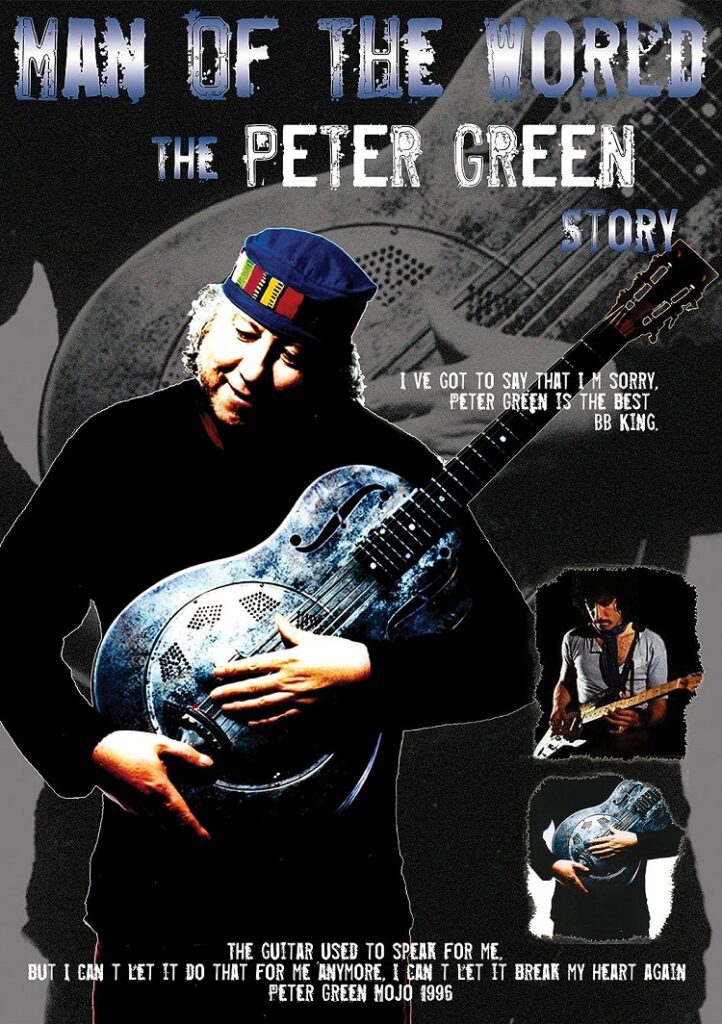
Written by Glen Boyd
If you know your rock history, you know that before there was the soft-rock hit machine of Rumours-era Fleetwood Mac, there was “the other Fleetwood Mac,” a much different sounding animal (and then some) than the one you most likely remember now.
During a brief, three-year stretch that ran from roughly 1968 through about 1970, the British blues-rock band known first as Peter Green’s Fleetwood Mac (before dropping the Green name at his own request), recorded three well-received albums, including the classic Then Play On. But then, just as they seemed on the threshold of a Led Zeppelin sized breakthrough to superstardom, Green abruptly quit and disappeared from public view, fueling rumors of everything from drugs and mental illness, to his having run off to join a religious cult.
Man of the World (taken from the same Peter Green song guitarist and Fleetwood Mac bandmate Jeremy Spencer says reads like a suicide note) is an often fascinating, but equally frustrating study of the guitarist and songwriter, once spoken of in the same breath as guitar-Gods like Clapton, Page, and Hendrix, but who today is somewhat sadly remembered mostly by a small, but devoted following of music critics and guitar geeks.
Unless you fall into one of those two categories, the first half of this film may bore you just a bit, being the often-told, standard rags-to-riches then back to rags rock-doc story that once fueled the Behind The Music franchise for VH-1. Peter Green first makes his name as a brilliant guitarist by replacing Eric Clapton in John Mayall’s Blues Breakers outfit (which at the time was something of a farm system for breeding future guitar legends). Green even manages to steal the “God” label – immortalized on graffiti scrawled walls throughout England at the time – away from Clapton. From there, he leaves Mayall behind, taking drummer Mick Fleetwood and bassist John McVie along with him to form Fleetwood Mac, naming the band after his rhythm section in what turned out to be a prescient act of charity, leaving them a name they could continue using after he left.
During the band’s first major American tour, they are introduced to LSD by the Grateful Dead, leading to the usual sex, drugs and rock and roll adventures of the day for most of the band (which by now also included guitarists Jeremy Spencer and Danny Kirwan). But also to the beginnings of far more serious problems for Green. The second, and far more interesting, half of Man of the World focuses in on this period.
Already a formidable guitarist, Green also began to display remarkable growth as a songwriter during this time. Penning such future classics as “Albatross,” “Oh Well (Parts 1 & 2)” and “Black Magic Woman,” Green seemed to be inspired at least in part by the consciousness expanding qualities of the drugs as his writing progressed well past the blues foundation of his previous work. But as the commercial and artistic fortunes of Fleetwood Mac began to likewise grow, so too did Green’s discomfort, likely amplified by the drugs, with the fame that came with it.
Interviews with Fleetwood, McVie, and Spencer shed new light on just when it all began to unravel, with all three agreeing that it likely began with a strange encounter with a bizarre religious cult in Munich during a tour stop in Germany. Shortly afterwards, Green became increasingly troubled by his growing wealth in particular, repeatedly badgering manager Cliff Adams about how to administer such things as giving sandwiches away to the homeless, before eventually just walking away altogether.
Where the film starts to go astray is when it covers the years that followed, which are presented as a kind of blur of mental institutions, electro-convulsive therapy, and destitution without ever really explaining any of it. In one particularly unsettling scene, Green – the one-time Guitar God and Rock Star who struck the classic Jesus Christ pose – is virtually unrecognizable with his wild-scraggly hair and long overgrown fingernails. It is an image that could have been taken straight out of the Howard Hughes story. The frustration here comes when the present-day Peter Green is shown throughout the film as a seemingly normal, quite ordinary balding English gentleman doing mundane things like fishing, without ever really explaining how he got from “there” to “here.” Green’s post Fleetwood Mac work as a solo artist – which though spotty, also showed occasional flashes of his former brilliance (check out 1979’s In The Skies, if you can find it) – is also given surprisingly short shrift here.
In addition to comments from the other surviving Fleetwood Mac members and Green himself, Man of the World also features interviews with fellow rock peers Carlos Santana, John Mayall, and Noel Gallagher. DVD and Blu-ray extras – which strangely are not given any sub-menu of their own – include featurettes on Green showing off his guitar collection (which he keeps in a caged room under lock and key) and former manager Adams reading a bizarre letter that Green wrote from Hawaii shortly after leaving the band.